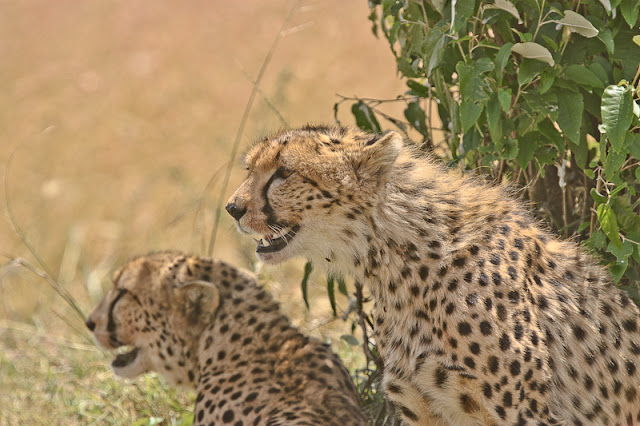The rains have subsided, giving us clear skies for great sunrises and sunsets, including clear night skies for stargazing. The temperatures have dropped – the morning and evenings are cold with temperatures ranging between 18-19ºC. Daytime temperatures are 27-28ºC.
The seasonal crossings along Talek, Olare Orok and Intiakitiak rivers are manageable with 4WD vehicles. The rivers are however drying up faster than usual.
The grass is lush and green after the rains. The old golden red oat grass is regenerating and is green, making it more palatable for the grazers like the buffalos, zebras, topis, Thomson gazelles and mixed feeders like the elephants and impalas.
RESIDENT PLAINS GAME
The resident plains game has stayed put where the grass is short and easier to graze.
To reach these short-grass plains one has to drive through tall grass where the elephants and buffalos are. The warthogs prefer to be in their company because they are alerted to danger.
It’s easy to see big herds now especially around the Topi Plains, Paradise Plains, Olkiombo Plains which are all close to the Mara Intrepids Camp.
PREDATORS SIGHTINGS
LIONS
The prides are doing well. Some individuals are teaming up with the family prides so as to improve their team work to bring down big prey. About two weeks ago, the Olkiombo Pride killed a buffalo at Lugga ya Njoroge on the way to the Sundowner Tree.
The elands and buffaloes have become easy prey for the lions. This is because they are suffering from the recent outbreak of the foot and mouth disease.
The Olkiombo Pride also killed an eland just east of the private Mara Explorer Camp. This pride has six lionesses and three cubs of three month old.
This is Notch’s territory and he and his boys are the ‘owners’ of the Olkiombo Pride. The boys joined the pride when the females brought down the buffalo. After the kill, the males went to Olkeju Ronkai where the other pride with young cubs is. It is also part of Notch’s pride and territory.
The Olkeju Ronkai Pride now has seven lionesses and eight cubs of different ages.
The Ridge Pride is opposite the Foot Bridge on Posse Plains with their seven cubs of different ages that are looking healthy and well fed.
The Paradise Pride has been taken over by three new mature males. The one with a black mane is said to have come from Ngiro-Aare in the Mara Triangle. The ‘new’ lions are looking ready for any challenge and are already mating with the Paradise lionesses.
The Marsh Pride has left the marsh and is now at Bila Shaka, feasting on an elephant carcass. Their males are mating with the rest of the pride’s females on Topi Plains.
LEOPARDS
Leopard’s sightings have been very good, with Olive and her two young cubs at the Big Rock between Mara Intrepids Camp and Rekero Crossing.
At Shemorta, which is by the pump house along the Mara River there are five leopards - a female and two cubs and a young female mating within the same territory. At Paradise Plains, another female leopard with two cubs of seven months, was seen with a male Thomson gazelle on the Leopard Tree.
CHEETAHS
A female cheetah east of Mara Intrepids Camp has two female cubs of six month old. This area is full of gazelles and the cheetahs have zero competition from their competitors.
Heritage Hotels (Kenya) manages two luxury camps in the Masai Mara - Mara Explorer and Mara Intrepids - in the confluence of the four game viewing areas of the Masai Mara. The camps are on the banks of the Talek River, with most tents spread along the banks. Report and pictures by Paul Kirui & Guides, Mara Explorer & Mara Intrepids Camp ©Heritage Hotels Ltd, Kenya.http://www.heritage-eastafrica.com/
Heritage Hotels (Kenya) manages two luxury camps in the Masai Mara - Mara Explorer and Mara Intrepids - in the confluence of the four game viewing areas of the Masai Mara. The camps are on the banks of the Talek River, with most tents spread along the banks. Report and pictures by Paul Kirui & Guides, Mara Explorer & Mara Intrepids Camp ©Heritage Hotels Ltd, Kenya.http://www.heritage-eastafrica.com/








.JPG)
.JPG)
.JPG)
.JPG)
.JPG)























